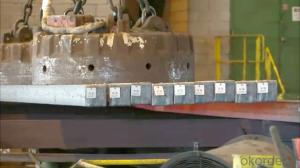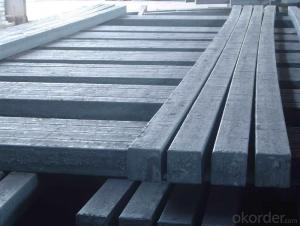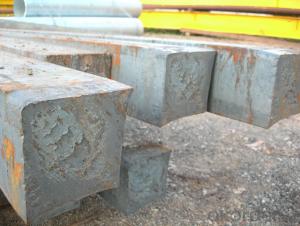Prime square alloy steel billet 145mm Q235
- Loading Port:
- Shanghai
- Payment Terms:
- TT OR LC
- Min Order Qty:
- 100 m.t.
- Supply Capability:
- 10000 m.t./month
OKorder Service Pledge
OKorder Financial Service
You Might Also Like
Structure of Prime square alloy steel billet 145mm Q235

Description of Prime square alloy steel billet 145mm Q235
1) Excellent corrosion resistance: The zinc layer provides a good protection of Pre-painted Galvanizeed Steel Sheet.
2) High heat resistance: The reflective surface of the material aids in efficiently reflecting the sunlight away and in turn reducing the amount of heat transmitted. The thermal reflectivity converts into energy savings.
3) Aesthetics: Pre-Painted Galvanized steel sheet is available in plethora of patterns and multiple sizes as per the requirements that given by our customers.
4) Versatility: can be used in the various areas.

Main Feature of Prime square alloy steel billet 145mm Q235
Manufacture Progress:HRC-CRC-GALVANIZED-COLOR COATED
Application : Construction, electrical, transportation, steel plant, composite board plant, steel tile factory
Payment & Shipping Terms:T/T ,L/C, and FOB CHINA
Minimum Order Quantity: 25Tons
Packge Type: Moisture-proof paper inner,Steel outside,Bundle by steel rope.
Package in Container : Wood as a foot pad, wire rope reinforcement,PPGI steel coil tied together by steel rope.
Applications of Prime square alloy steel billet 145mm Q235
1) Excellent corrosion resistance: The zinc layer provides a good protection of Pre-painted Galvanizeed Steel Sheet.
2) High heat resistance: The reflective surface of the material aids in efficiently reflecting the sunlight away and in turn reducing the amount of heat transmitted. The thermal reflectivity converts into energy savings.
3) Aesthetics: Pre-Painted Galvanized steel sheet is available in plethora of patterns and multiple sizes as per the requirements that given by our customers.
4) Versatility: can be used in the various areas.

Specifications of Prime square alloy steel billet 145mm Q235
Product | Billet |
Material Grade | SGCC / SGCH / DX51D+AZ, etc |
Thickness | 0.6-3.0mm |
Width | 500-1500mm |
Tolerance | Thickness: +/-0.02mm , Width:+/-2mm |
Zinc-coating | Z30-150g/m2 |
Technique | Raw material: Hot rolled steel coil --> Cold rolled_>hot dipped galvalume |
Surface | Dried, Chromated, Unoiled |
Spangle | Regular spangle , small spangle, zero spangle |
ID | 508MM 610MM |
Coil weight | 1-25MT |
Export package | Cardboard inner sleeves, Waterproof paper, galvanized steel covered and steel strip packed |
FAQ of Prime square alloy steel billet 145mm Q235
We have organized several common questions for our clients,may help you sincerely:
1. How Can I Visit There?
Our company is located in Tianjin City, China, near Beijing. You can fly to Tianjin Airport Directly. All our clients, from home or aboard, are warmly welcome to visit us!
2. How Can I Get Some Sample?
We are honored to offer you sample.
3. Why choose CNBM?
we always fix steel produce in container well to make it safe arrive at destination port
we always provide best and professional forward service for our buyer
we always apply 14days free detention for our buyers container in destination
we provide one set After-sales service for our buyer
we provide China inland steel market price report
we help our buyer become number one in local market .
- Q:Can steel billets be used in the production of bicycles?
- Yes, steel billets can be used in the production of bicycles. Steel billets are semi-finished products made from steel and can be further processed into various shapes and sizes. In the case of bicycles, steel billets can be shaped and formed into different bicycle components such as frames, forks, handlebars, and other structural parts. Steel is a popular choice for bicycle production due to its strength, durability, and affordability. It provides excellent stiffness, stability, and resistance to deformation, making it suitable for various types of bicycles, including road bikes, mountain bikes, and hybrid bikes. Additionally, steel can be easily welded, allowing for customization and repairability of bicycle frames.
- Q:Can steel billets be used in the production of automotive components?
- Yes, steel billets can be used in the production of automotive components. Steel billets are semi-finished steel products that are typically used to produce various types of steel products, including automotive components. They can be further processed through rolling, forging, or other manipulation techniques to form the desired shape and size of the automotive component. Steel is a preferred material for automotive components due to its high strength, durability, and ability to withstand harsh operating conditions. Moreover, the use of steel billets allows for flexibility in manufacturing, as they can be tailored to meet specific design requirements and performance specifications of different automotive components.
- Q:How are steel billets used in the manufacturing of oil and gas equipment?
- Steel billets are used in the manufacturing of oil and gas equipment by being shaped and formed into various components such as pipes, valves, and fittings. These billets are heated and then forged, molded, or rolled to create the required shapes and dimensions. The resulting steel components possess high strength, durability, and corrosion resistance, making them suitable for the harsh conditions encountered in the oil and gas industry.
- Q:What is the role of steel billets in the manufacturing of offshore structures?
- Steel billets play a crucial role in the manufacturing of offshore structures as they serve as the foundational raw material for creating various components such as beams, columns, and plates. These billets are first heated and then shaped or molded into desired forms through processes like rolling or forging. Their high strength, durability, and resistance to corrosion make them ideal for withstanding the harsh marine environment in which offshore structures operate. Overall, steel billets are essential in ensuring the structural integrity and longevity of offshore structures, providing the necessary strength and stability to withstand the challenging conditions of the open seas.
- Q:How are steel billets used in the production of mining components?
- Steel billets play a vital role in the mining component production process. They serve as the initial stage in the manufacturing of diverse mining equipment and components. To begin with, steel billets are melted and cast into specific shapes and sizes to meet the mining industry's requirements. These billets are subjected to extremely high temperatures and then poured into molds to achieve the desired shape. This casting process enables the creation of various mining components like gears, shafts, and valves. Once the steel billets have been cast into the desired shape, they undergo further processing to enhance their strength and durability. This involves employing different techniques such as forging, where the billets are exposed to high pressure and heat to enhance their mechanical properties. Forged steel components are widely used in mining applications due to their exceptional strength and resistance to wear and tear. Additionally, steel billets are frequently machined to attain precise dimensions and finishes necessary for mining components. Machining encompasses cutting, drilling, and shaping the billets using specialized tools and machinery. This step guarantees that the final mining components meet the precise specifications required for efficient and reliable operation in mining environments. In general, steel billets are indispensable in the production of mining components as they serve as the raw material from which these components are manufactured. The versatility and durability of steel make it an ideal choice for mining applications, where equipment is subjected to demanding conditions. By commencing with steel billets and employing various manufacturing processes, mining companies can produce high-quality components that are crucial for the efficient and safe operation of mining activities.
- Q:How do steel billets contribute to the overall corrosion protection of a structure?
- Steel billets, which are semi-finished steel products, play a significant role in contributing to the overall corrosion protection of a structure. They contribute to corrosion protection in several ways: 1. High-quality steel composition: Steel billets are manufactured using high-quality steel that consists of various alloying elements, such as chromium, nickel, and molybdenum. These alloying elements enhance the corrosion resistance of the steel, making it less susceptible to rust and corrosion. 2. Protective coating: Steel billets are often coated with protective layers, such as zinc or epoxy coatings. These coatings act as a barrier between the steel surface and the external environment, preventing moisture, oxygen, and other corrosive substances from reaching the steel and causing corrosion. 3. Durability and strength: Steel billets are known for their high strength and durability. When used in the construction of a structure, they provide a strong foundation and structural support. This strength and durability minimize the chances of structural damage and corrosion, ensuring the longevity and stability of the structure. 4. Weldability: Steel billets are highly weldable, allowing for easy and efficient joining of steel components during construction. Proper welding techniques and materials can further enhance the corrosion resistance of the structure by maintaining the integrity and continuity of the protective coatings. 5. Maintenance and repair: In case of any damage or corrosion on the structure, steel billets can be easily replaced or repaired. This ensures that the affected area can be fixed without compromising the overall integrity and corrosion protection of the structure. Regular maintenance and repair of steel billets contribute to the long-term corrosion protection of the entire structure. In summary, steel billets contribute to the overall corrosion protection of a structure through their high-quality composition, protective coatings, durability, weldability, and ease of maintenance and repair. By incorporating steel billets into construction projects, engineers and architects can ensure the longevity, safety, and corrosion resistance of structures in various environments.
- Q:What are the main challenges in the transportation of steel billets?
- The main challenges in the transportation of steel billets include ensuring proper handling and securing of the heavy and bulky loads, preventing damage or deformation during loading and unloading processes, and complying with safety regulations for transporting hazardous materials. Additionally, factors such as limited availability of specialized equipment, fluctuations in fuel prices, and coordinating logistics for long-distance shipments can pose challenges for efficient and cost-effective transportation of steel billets.
- Q:What is the typical surface finish of a steel billet?
- Depending on the specific application and processing method, the surface finish of a steel billet can vary. Generally, steel billets are produced with a rough surface finish that may have imperfections like scale, oxide layers, or minor irregularities. This is primarily because of the manufacturing process involving hot rolling or casting. Hot rolling is a common method for producing steel billets. In this process, the steel is heated to high temperatures and shaped by passing it through rollers. This high-temperature process can result in the formation of scale or oxide layers on the billet's surface, making it appear rough and textured. Similarly, steel billets produced through casting methods like continuous casting or ingot casting may also have a rough surface finish. During these processes, the molten steel solidifies in molds, leading to surface imperfections like cracks, pits, or unevenness. However, it's important to note that the surface finish of steel billets can be improved through additional processes such as descaling, shot blasting, or grinding. These processes help remove scale, oxide layers, or other imperfections, resulting in a smoother and more uniform surface finish. Furthermore, steel billets intended for specific applications like precision machining or forging may undergo additional surface treatments like polishing or coating to achieve the desired finish. In conclusion, the typical surface finish of a steel billet is rough and may have scale, oxide layers, or minor irregularities. However, various additional processes can be used to improve the surface finish according to specific requirements and applications.
- Q:What are the main applications of steel billets in the aerospace industry?
- Steel billets are an essential component in the aerospace industry, finding numerous applications due to their exceptional strength, durability, and thermal properties. One of the main applications of steel billets in the aerospace industry is in the production of aircraft structural components. These billets are commonly used to manufacture critical parts such as landing gear, wing spars, fuselage frames, and engine mounts, providing the necessary strength and stability required for safe and efficient flight. Moreover, steel billets are also utilized in the aerospace industry for the production of engine components. Due to their high heat resistance and ability to withstand extreme temperatures, steel billets are used to manufacture turbine blades, shafts, and other critical parts within jet engines. These components must withstand intense heat and pressure, and steel billets offer the necessary properties to ensure reliable and efficient engine performance. Additionally, steel billets play a crucial role in the aerospace industry through their application in the production of fasteners and connectors. These components are vital for securely joining various parts of an aircraft, ensuring structural integrity and safety during flight. Steel billets are used to manufacture high-strength bolts, screws, and other fasteners, providing the necessary strength and reliability for aerospace applications. Furthermore, steel billets are often employed in the aerospace industry for the production of hydraulic and pneumatic systems. These systems are responsible for controlling the aircraft's movement, landing gear operation, and other crucial functions. Steel billets are used to manufacture hydraulic cylinders, valves, and tubes, offering the necessary strength and resistance to withstand high pressures and extreme conditions. In summary, the main applications of steel billets in the aerospace industry include aircraft structural components, engine parts, fasteners and connectors, as well as hydraulic and pneumatic systems. Their exceptional strength, durability, and thermal properties make steel billets indispensable for ensuring the safety, efficiency, and reliability of aerospace operations.
- Q:How are steel billets used in the production of transmission towers?
- Steel billets are an essential component in the production of transmission towers. These billets, which are semi-finished steel products, serve as the raw material for the construction of these towers. To begin, the steel billets are first heated at extremely high temperatures in a furnace. This heating process, known as hot rolling, helps to soften the billets and make them more malleable, allowing them to be easily shaped and formed into the desired structure of the transmission tower. Once the billets have been heated, they are then passed through a series of rolling mills, where they are shaped into long, cylindrical sections known as steel bars. These bars are then further processed and cut to the required length and dimensions, depending on the specific design and requirements of the transmission tower. After the bars have been cut and shaped, they undergo a process called galvanization. This involves coating the steel bars with a layer of zinc, which provides corrosion resistance and protects the tower from environmental elements such as moisture and rust. Finally, the galvanized steel bars are assembled and welded together to form the intricate framework of the transmission tower. The strength and durability of the steel billets used in this process ensure that the tower can withstand the heavy loads and extreme weather conditions it is subjected to. Overall, steel billets play a crucial role in the production of transmission towers as they provide the necessary strength, flexibility, and corrosion resistance required for these structures. Their ability to be shaped and formed into the desired dimensions, along with their durability, make them an ideal material for the construction of transmission towers.
1. Manufacturer Overview |
|
|---|---|
| Location | |
| Year Established | |
| Annual Output Value | |
| Main Markets | |
| Company Certifications | |
2. Manufacturer Certificates |
|
|---|---|
| a) Certification Name | |
| Range | |
| Reference | |
| Validity Period | |
3. Manufacturer Capability |
|
|---|---|
| a)Trade Capacity | |
| Nearest Port | |
| Export Percentage | |
| No.of Employees in Trade Department | |
| Language Spoken: | |
| b)Factory Information | |
| Factory Size: | |
| No. of Production Lines | |
| Contract Manufacturing | |
| Product Price Range | |
Send your message to us
Prime square alloy steel billet 145mm Q235
- Loading Port:
- Shanghai
- Payment Terms:
- TT OR LC
- Min Order Qty:
- 100 m.t.
- Supply Capability:
- 10000 m.t./month
OKorder Service Pledge
OKorder Financial Service
Similar products
New products
Hot products
Hot Searches
Related keywords


































